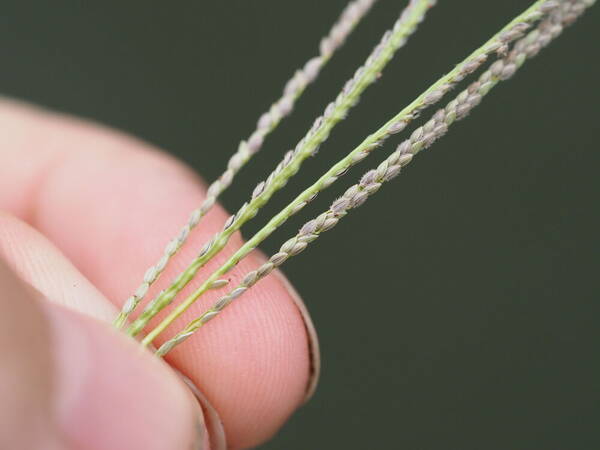Info
Subfamily: Panicoideae
Genus etymology: Digitaria = "having fingers" [Latin] refering to the inflorescence structure
Species etymology: violascens = "turning purplish" [Latin] refering to the color of the fertile lemma at maturity
Photosynthetic type: C4 (warm season)
Nativity: naturalized - accidental
First recorded in Hawaiʻi: 1852
Map


Inflorescence

Plant


Spikelets










Collar


Description
Plants annual or of indefinite duration. Culms 15-60 cm, erect, usually not branching from the upper nodes; nodes 3-4. Sheaths glabrous or sparsely pubescent; ligules 0.6-2.5 mm; blades 1.5-9 cm long, 3-5 mm wide, glabrous, with papillose-based hairs basally. Panicles with 2-7 spikelike primary branches in 1-2 verticils; primary branches 3-12 cm, erect to ascending, axes 0.6-1 mm wide, wing-margined, wings at least 1/2 as wide as the midribs, lower and middle portions of the branches bearing spikelets in groups of 3(4, 5); secondary branches rarely present; axillary inflorescences absent. Spikelets 1.2-1.7 mm, homomorphic, narrowly elliptic. Lower glumes absent or a veinless, membranous rim; upper glumes 1.2-1.4 mm, 1/2 as long as to almost equaling the upper lemmas, 3-veined, appressed-pubescent, hairs minutely verrucose; lower lemmas 1.2-1.7 mm, 5-7-veined, veins equally spaced, region between the 2 inner lateral veins and the margins appressed-pubescent, hairs 0.3-0.5 mm, smooth or minutely verrucose (use 50x magnification), verrucose hairs most abundant near the lemma bases; upper lemmas light brown when immature, dark brown at maturity; anthers 0.4-0.6 mm. 2n = 36.
(Description source: Barkworth, M.E., Capels, K.M., Long, S. & Piep, M.B. (eds.) 2003. Flora of North America, north of Mexico. Volume 25. Magnoliophyta: Commelinidae (in part): Poaceae, Part 2. Oxford University Press, New York. 783 pp http://floranorthamerica.org/Digitaria_violascens )
Annuals or sometimes perennials; culms erect or decumbent at base, slender, 20-60 cm tall, glabrous, leaves crowded near base. Sheaths 1-6 cm long, compressed, keeled; ligule membranous, ca. 1 mm long; blades often red-tinged, flat, usually 2-6 (-10) cm long, 3-6 mm wide, margins glabrous or scaberulous, upper surface occasionally sparsely pilose at base. Inflorescence of 2-9 subdigitate racemes on an axis 2-5 cm long, racemes usually spreading or recurved, 3-12 cm long, slender, rachis narrowly winged, 0.5-0.7 mm wide; spikelets usually dark brown, in groups of 3, elliptic, 1.5-1.7 mm long, pedicels subterete, the longest one 1.5-2 mm long, scabrous, the others 0.7-1 mm and 0.2-0.5 mm long; first glume absent, second glume 1-1.2 mm long, 3-nerved, appressed silky pilose between the nerves, apex obtuse; first lemma 1.5-1.7 mm long, 5-nerved, obscurely appressed silky pilose between the nerves, apex obtuse; second lemma dark brown, 1.5-1.7 mm long, apex acute; palea similar to lemma. Caryopsis whitish, 1-1.2 mm long, elliptic-ovate. [2n = 18, 36.]
(Description source: O’Connor, P.J. 1990. Poaceae, pp. 1481–1604. In: Wagner W.L., Herbst D.R. & Sohmer S.H. (eds.)., Manual of the flowering plant of Hawaiʻi. Vol. 2. University of Hawaii Press & Bishop Museum Press, Honolulu )